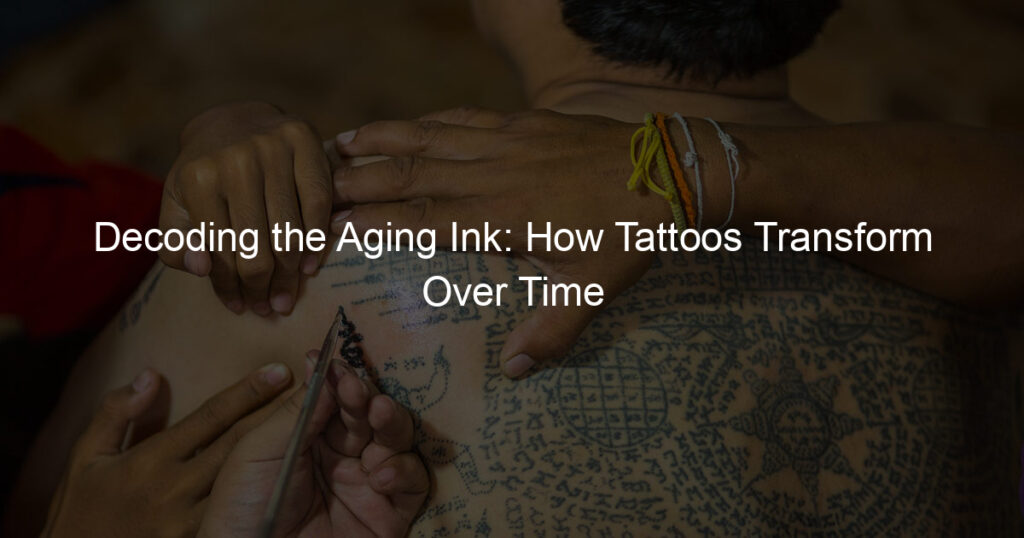
Introduction: Decoding the Aging Ink
Have you ever wondered how tattoos change over time? Just as our skin ages, so do the tattoos we etch onto it. This introduction will help you understand the concept of tattoo aging and why it’s important to study how tattoos transform over time.
Tattoo aging is a natural process that occurs as the ink in your skin begins to fade and spread over time. This is due to various factors such as exposure to sunlight, the depth of the ink, and your body’s immune response. Just like a vibrant painting slowly losing its luster, tattoos too, experience a similar transformation. But don’t worry, this doesn’t mean your tattoo will disappear overnight. It’s a gradual process that takes place over many years.
Understanding how tattoos age is crucial for both tattoo artists and those who wear tattoos. For artists, it helps them improve their techniques and use of ink to ensure the longevity of their work. For individuals with tattoos, it provides insights into how to best care for their tattoos to maintain their vibrancy and clarity. Furthermore, it helps set realistic expectations about how a tattoo will look several years down the line.
In the following sections, we will delve deeper into the tattoo aging process, discuss whether tattoo fading is an inevitable process, and provide tips on tattoo care over time. So, let’s embark on this fascinating journey of understanding the evolution of tattoos over time.
The Tattoo Aging Process: A Closer Look
As we delve deeper into the world of tattoos, it’s important to understand how they change as we age. Just like our skin, tattoos also go through an aging process. Let’s take a closer look.
How Tattoos Change with Age
Over time, tattoos undergo changes. These changes are influenced by various factors, including the quality of the ink used, the type of skin, and exposure to sunlight. But what exactly happens to tattoos as they age? Let’s explore.
-
- Impact of time on tattoos: The science behind the transformation
When you get a tattoo, the ink is injected into the second layer of your skin, known as the dermis. Over time, your body’s immune system tries to get rid of the foreign ink particles, leading to the fading of the tattoo. Additionally, as we age, our skin loses its elasticity and collagen, causing the tattoo to distort and blur.
-
- Case study: Evolution of a tattoo over a decade
Let’s consider the case of a simple black ink tattoo, a small heart on the wrist. When it was first inked, the lines were sharp and the color was vibrant. Fast forward ten years, the lines have blurred and the color has faded. This is due to the body’s natural aging process and the constant exposure to sunlight. This case study clearly illustrates the evolution of a tattoo over a decade.
In conclusion, the aging process of tattoos is inevitable. However, with proper care and protection from sunlight, the longevity of your tattoo can be enhanced. Remember, tattoos are a form of self-expression and their evolution over time is a testament to your life’s journey.
Factors Influencing the Longevity of Tattoos
When it comes to the lifespan of a tattoo, several factors can influence how long it remains vibrant and clear. Let’s take a closer look at these factors:
-
- Quality of Ink Used
The quality of the ink used can significantly impact the longevity of a tattoo. High-quality inks tend to last longer and fade less over time. They are also less likely to cause allergic reactions or other skin issues. On the other hand, low-quality inks may fade quickly and can even lead to infections. Therefore, it’s crucial to ensure your tattoo artist uses high-quality ink.
-
- Skin Type and Care
Your skin type and how you care for it also play a vital role in the lifespan of your tattoo. Dry skin can cause a tattoo to fade faster, while oily skin may blur the lines over time. Regular moisturizing and proper aftercare can help maintain the vibrancy of your tattoo. It’s also essential to avoid picking or scratching at the tattoo, as this can cause damage and fading.
-
- Exposure to Sunlight
Excessive exposure to sunlight can significantly shorten the lifespan of a tattoo. The sun’s UV rays can break down the ink particles, causing the tattoo to fade over time. Therefore, it’s advisable to protect your tattoo from direct sunlight, especially during the first few weeks after getting it. Using a sunscreen with a high SPF can also help protect your tattoo when you’re out in the sun.
In conclusion, the longevity of a tattoo is influenced by various factors, including the quality of ink used, skin type and care, and exposure to sunlight. By understanding these factors, you can take the necessary steps to ensure your tattoo lasts as long as possible.
Tattoo Fading: An Inevitable Process?
Many people who get tattoos often wonder if the vibrant colors and sharp lines will stay the same over time. The truth is, tattoo fading is a natural process. But why does it happen and how can we slow it down?
Understanding Tattoo Fading
Before we delve into the reasons behind tattoo fading, it’s important to understand what exactly happens when you get a tattoo. The tattoo needle punctures your skin, depositing ink into the second layer, known as the dermis. This layer is much more stable than the outer layer, the epidermis, which is why tattoos are permanent. However, they are not immune to fading.
-
- Why does tattoo ink fade over time?
Tattoo ink fades over time due to several factors. The primary reason is the body’s natural process of cell renewal. Your skin cells are constantly regenerating, and as old cells die, they are replaced by new ones. This process can cause the tattoo ink to break down and fade.
Another significant factor is exposure to sunlight. Ultraviolet (UV) rays can cause the ink to break down faster, leading to a faded tattoo. Other factors include the quality of the ink used, the depth at which the ink was injected, and your body’s individual healing process.
-
- Key takeaways: How to slow down the fading process
While tattoo fading is inevitable, there are steps you can take to slow down the process and keep your tattoo looking vibrant for longer.
Firstly, protect your tattoo from the sun. Apply a high SPF sunscreen whenever you’re going to be exposed to sunlight. Secondly, keep your skin hydrated. Dry skin can make a tattoo look dull and faded, so drink plenty of water and moisturize regularly.
Finally, choose a reputable tattoo artist who uses high-quality ink. The better the quality of the ink, the longer your tattoo will stay vibrant. Remember, a tattoo is a lifelong commitment, so it’s worth investing in the best.
Impact of Lifestyle on Tattoo Fading
Our lifestyle choices can have a significant impact on how our tattoos age and fade over time. Two key factors that influence this process are our diet and hydration levels, as well as our consumption of substances like tobacco and alcohol.
-
- Role of Diet and Hydration
What we eat and drink plays a crucial role in maintaining the vibrancy of our tattoos. A balanced diet rich in vitamins and minerals, particularly Vitamin C and E, can help to maintain the health of our skin and slow down the fading process. Similarly, staying well-hydrated is essential. Water helps to keep our skin moisturized and healthy, which can help to preserve the clarity and brightness of our tattoos.
-
- Effect of Smoking and Alcohol Consumption
Smoking and excessive alcohol consumption can accelerate the fading of tattoos. Both habits can lead to skin damage and dehydration, which can cause tattoos to appear dull and faded. Smoking, in particular, can cause the skin to age prematurely, which can lead to a loss of tattoo clarity over time. Therefore, limiting or avoiding these habits can help to prolong the life of your tattoos.
In conclusion, our lifestyle choices can have a significant impact on the longevity and vibrancy of our tattoos. By maintaining a healthy diet, staying well-hydrated, and limiting harmful habits like smoking and excessive alcohol consumption, we can help to slow down the tattoo fading process and keep our ink looking fresh and vibrant for longer.
Tattoo Care Over Time: Ensuring the Longevity of Your Ink
When it comes to tattoos, care doesn’t stop once the ink has dried. It’s a lifelong commitment to ensure the vibrancy and longevity of your body art. Let’s explore some essential maintenance tips that will help you keep your tattoo looking fresh and vibrant for years to come.
Essential Tattoo Maintenance Tips
Here are three key steps you should follow to maintain the quality of your tattoo over time:
-
- Proper Cleaning and Moisturizing
Proper cleaning and moisturizing are the first steps to maintaining your tattoo. It’s crucial to keep the tattooed area clean to avoid infection and promote healing. Use a mild, fragrance-free soap and gently pat the area dry. After cleaning, apply a thin layer of fragrance-free moisturizer to keep the skin hydrated and healthy. Remember, over-moisturizing can lead to color loss, so moderation is key.
-
- Protection from the Sun
Ultraviolet (UV) rays from the sun can cause your tattoo to fade over time. To protect your tattoo, apply a high-SPF, broad-spectrum sunscreen whenever you’re outdoors. Consider wearing protective clothing over the tattooed area when possible. This will help maintain the vibrancy of your ink for a longer period.
-
- Regular Touch-ups
Even with the best care, tattoos can fade over time. Regular touch-ups by a professional tattoo artist can help restore the original vibrancy and detail of your tattoo. It’s recommended to get a touch-up every few years, depending on the quality of the ink and your skin type.
By following these essential tattoo maintenance tips, you can ensure the longevity of your ink and enjoy your body art for many years to come.
Tattoo Lifespan: How Long Can a Tattoo Last?
When you decide to get a tattoo, it’s natural to wonder how long it will last. After all, tattoos are a permanent form of body art. However, the lifespan of a tattoo can vary greatly depending on several factors. Let’s dive into these factors and look at some examples of tattoos that have stood the test of time.
-
- Factors affecting the lifespan of a tattoo
The lifespan of a tattoo is influenced by several factors. These include the quality of the ink used, the skill of the tattoo artist, the depth of the ink in the skin, and how well the tattoo is cared for after it’s done. Other factors such as exposure to sunlight, skin type, and the location of the tattoo on the body can also affect how long a tattoo lasts.
| Factor | Explanation |
|---|---|
| Quality of Ink | High-quality ink tends to last longer than low-quality ink. |
| Skill of Tattoo Artist | An experienced tattoo artist is more likely to create a tattoo that lasts. |
| Depth of Ink in Skin | Ink that is placed deeper in the skin tends to last longer. |
| Tattoo Care | Proper aftercare can significantly extend the life of a tattoo. |
-
- Examples of tattoos that have stood the test of time
There are many examples of tattoos that have stood the test of time. For instance, the tattoos found on the 5,300-year-old mummy known as Ötzi the Iceman are still visible today. More recent examples include the bold, black ink tattoos popularized by sailors in the early 20th century. These tattoos, often featuring nautical themes or symbols of love and luck, have retained their vibrancy for decades.
In conclusion, while tattoos are designed to be permanent, their lifespan can be influenced by a variety of factors. By understanding these factors and taking proper care of your tattoo, you can help ensure that your body art lasts as long as possible.
Conclusion: Embracing the Evolution of Tattoos Over Time
As we reach the end of our journey exploring the intricacies of tattoo aging, it’s essential to understand that tattoos are not just a form of body art. They are a testament to our life’s experiences, our passions, and our personal stories. Like us, they age and evolve over time, and this is a natural process that we should embrace.
-
- Accepting the natural aging process of tattoos
It’s crucial to accept that tattoos will fade and change over time. This is a natural part of the tattoo aging process, much like how our skin changes as we age. The colors may not be as vibrant, and the lines may not be as sharp, but this doesn’t mean that your tattoo has lost its value or meaning. Instead, it’s a reflection of the journey you and your tattoo have taken together.
-
- Final thoughts on maintaining the vibrancy of aging ink on skin
While we can’t stop the aging process, we can certainly take steps to maintain the vibrancy of our tattoos. Regular moisturizing, protecting your tattoo from the sun, and maintaining a healthy lifestyle can all contribute to keeping your tattoo looking its best for as long as possible. Remember, your tattoo is a part of you, and taking care of it is just as important as taking care of your overall health.
In conclusion, tattoos are a beautiful form of self-expression that carry a unique story. As they age, they evolve, much like we do. By embracing this evolution and taking steps to care for our tattoos, we can ensure that they continue to be a vibrant part of our personal narrative for years to come.
| Key Takeaways |
|---|
| Tattoos naturally age and evolve over time, much like we do. |
| Accepting this natural aging process is essential. |
| Regular care and maintenance can help maintain the vibrancy of your tattoo. |
| Your tattoo is a part of your personal narrative and should be cherished. |














